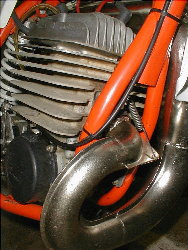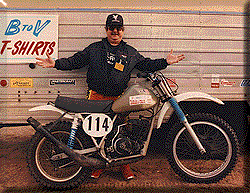What's the engine mystery
Shortly expained

The KTM 495 engine is over-quadratic. That means that the bore is bigger than
the stroke. The KTM 495 engine is extreme from this perspective. It has a bore
of ø92mm and a stroke of only 74mm. Most modern two stroke MX engines has almost
equal bore and stroke. One has found that to be ideal.
To fully understand the properties of such an engine one has to return to the
physics lessions in school, remember: 1Kg has the energy of 10Newton, to lift
1Kg 1meter you multiply 10N with 1meter to get 10Nm. Shortly The work performed
lifting 1Kg 1meter is 10Nm. Now if you lift the thing using a bar or slide it
upwards on a batten you don't have to apply the same force but you loose in
distance. The conclusion is that energy cannot go away. It can only be transformed.
If you are interested in the power developed, for example HP ratings you have
to divide the work conducted with the time it took. If you for example managed
to lift 100Kg (1000N) 3meters above the ground in two seconds the calculation
is 1000N x 3m = 3000Nm. 3000Nm / 2 is 1500W. The Watt rating is normally in
seconds. Thus 1500W equals 1.5KW. Now 1KW is 1.365 HP and the other way round
too. 1.365 HP * 0.735 is 1KW.
If you lift 100Kg 3meters in two seconds you develop 2.05HP (1.5KW)
How is this related to the 495 engine ?
The short stroke means two things. First that the piston is moving relatively slow in meters per second
since it travels shorter distance than if the stroke was longer. We'll take that again, the piston is moving
slower and travels less distance at a given RPM (Revolution Per Minute) than most engines having the same displacement.
The consequence is less moving energy. Kind of less flywheel effect. The other thing is that due to the large bore
the channels in the cylinder can be larger (wider) and the piston also has a larger surface to rest on, wall area.
Now the larger bore creates a higher piston pressure when the expanding gases burns out. Compare it to a hydraulic
piston. A large piston moves a short distance with great force whereas a small piston travels a long distance
but doens't have the force. The 495 piston moves a short distance but is pressed down with much greater force.
What will happen is that you will get a lively engine that can increase it's revolution per minute during a
very short period of time. On the other hand it wouldn't do wery well as engine in a truck since it easily
could be overloaded once you apply heavy work on it. The 495 engine doesn't develop extremely high HP ratings
but it could climb from a low RMP to high RPM in a extremely short period of time. This means that is should
and could out-accelerate almost anything dirtbike alike unless the straightway is very long and uphill. Then
the RPM climb is to no use and sheer power is more important. The larger cylinder wall area is mostly a good thing though
meaning a possibility to have wider channels allowing more fresh gases to come in and out. It is also
better from a wear point of view. On the other hand the higher piston pressure stresses the wrist pin
and the crank a bit more. The conclusion is that the larger bore, smaller stroke engine results in:
more difficult to start, higher risk of kickback, bad idle properties and difficult to ride smooth
when very slippery for example. On the other hand you get high power output, great acceleration
and a lively engine. The mass of the huge piston makes up most downsides when it comes to
idle and so on.
Why is bore and stroke normally equal?
This has no theoretic explanation except that we are humans and we consider some engines to be more
ridable (having a good powerband) than others. It has to do with the tracks, tires and how fast we
can shift comfortably. The practice has shown that the best engines from this point of view
is near quadratic (equal bore and stroke).
Is the 495 powerband bad?
No no, This is a rare bike from the past offering you some extreme properties. It isn't a compromise
but mere a heavy weapon if you are up to the task. The powerband isn't all too friendly but then again,
an open classer two stroke shouldn't be friendly. It can be described as a bit neurotic. Be a man
to stay in command.
Editor: bhahn@mxbikes.com
 |
Q: What's the fastest dirt bike ever made?
A: The fastest real dirt bike ever was the KTM 495. When I was
editor of Dirt Bike, we geared one to the moon and had Rod Bush do 123.75
miles per hour on El Mirage Dry Lake with that particular bike. I believe
the year was 1981. I have not heard of any other true stock dirt bike
go faster under verifiable conditions.
mxbikes comment:
The March 2002 issue of Dirtbike magazine had a new speed test with a hopped up
KTM 520, Kawasaki KX500 Husaberg 650 and a Honda XR 650R. They had serious problems reaching
110mph with all bikes and needed to shave some plastic off the bikes. In that article they
say. "the 1981 numbers where revieled to be doubtful" meaning the KTM 495 results.
I wasn't there in 1981 and have never tried this myself but there are a few factors that
I believe they overlooked. First of all, The Katoom 495 has the power to beat all of these
bikes to the turn, perhaps not the KX. The KX problem where the lack of higher gearing.
The KTM 495 doesn't have radiators and therefore no radiator shrouds. The cylinder and pipe is extremely
slim. It had drum brakes which is far smaller than the disks on these newer machines.
And if one believes that newer bikes is faster in top speed check out this test between Maicos.
1983 VS 2000 500cc Maicos. (a bit down on the page)
I believe that it would be very hard to have a new 500-650cc four stroke
dirtbike going as fast as a healthy KTM 495 from the early 80's.
|

